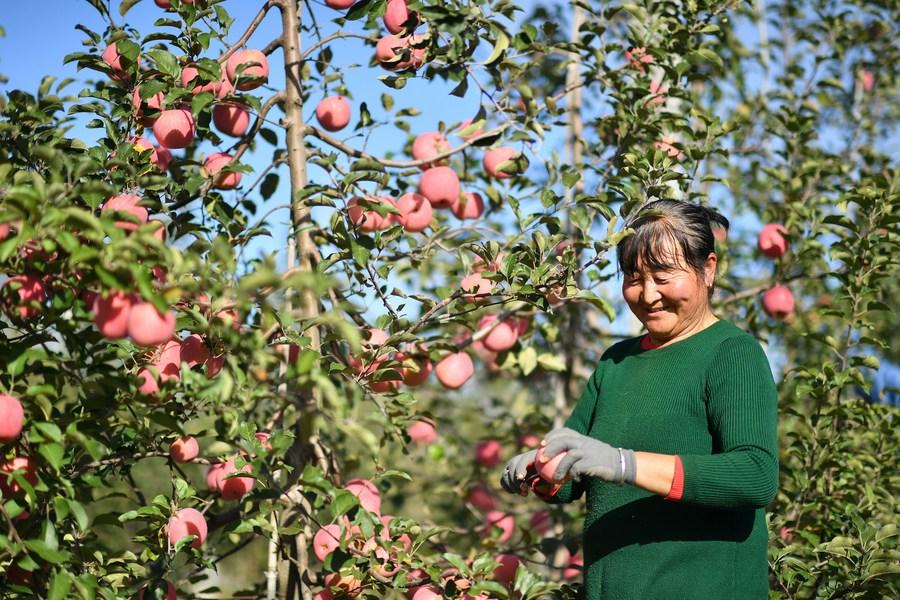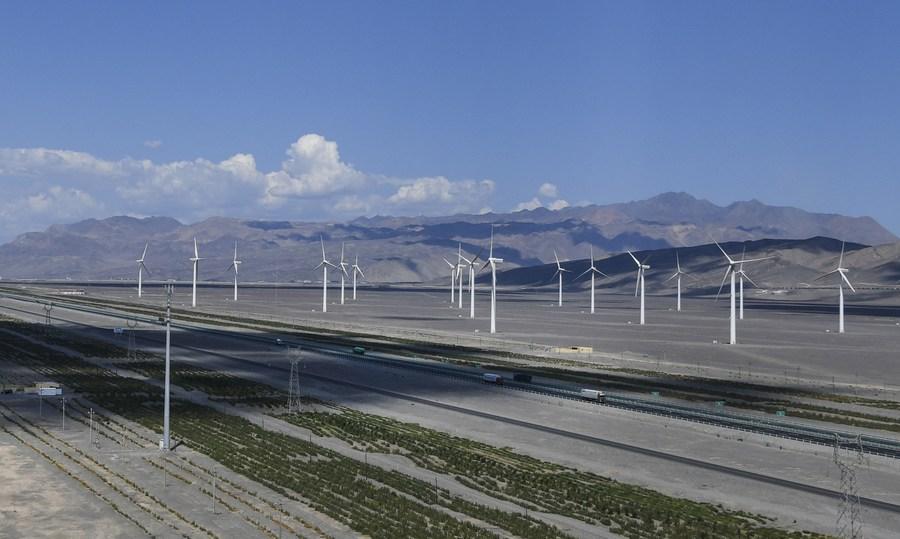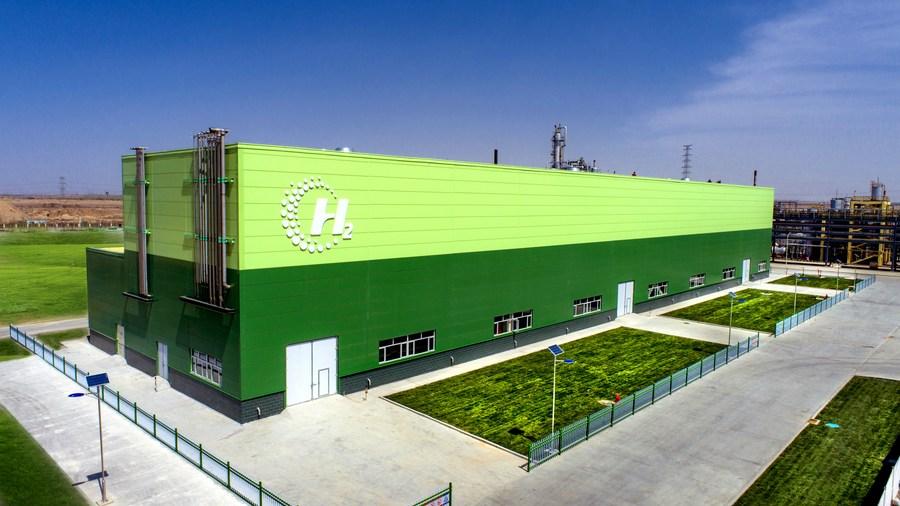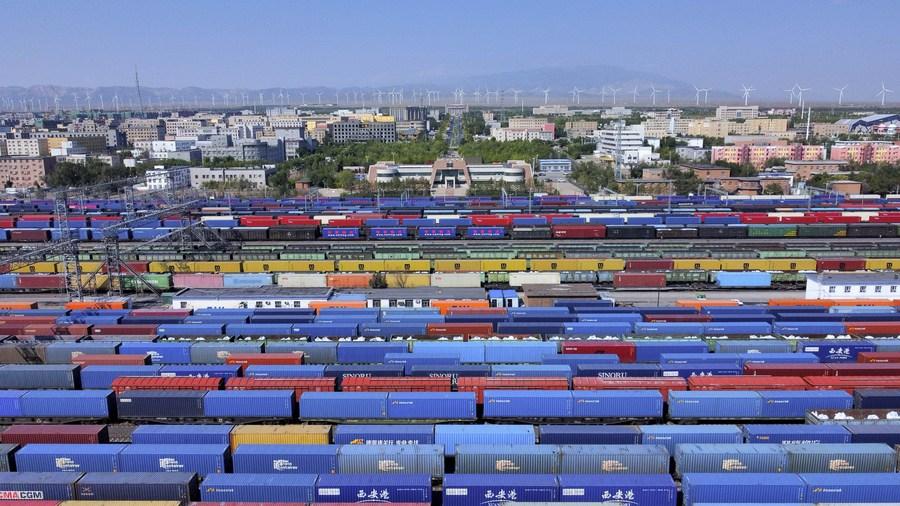Northwest China fosters new distinctive growth engines
* Based on natural advantages, northwest China is digging new opportunities in agriculture and establishing itself as a world factory for featured agri-foods.
* The northwestern Chinese region has become greener thanks to relentless efforts in ecological protection and restoration. Moreover, by exploring abundant renewable resources like solar power and wind power, it has embarked on a green development path.
* New trade corridors opened by China-Europe freight trains facilitate communication and cooperation between over 200 cities in Eurasia.
XI'AN, Dec. 27 (Xinhua) -- In the city of Dingxi, northwest China's Gansu Province, each quail-egg-like potato serving as a breeder seed weighs only 2 to 20 grams.
However, as a hot seller in the international market, these potatoes are sold individually instead of by weight and have been exported to many countries and regions, including Saudi Arabia, Türkiye, and Egypt.

Potatoes serving as breeder seeds are pictured at an agriculture and animal husbandry science and technology development company in northwest China's Gansu Province, Aug. 24, 2021. (Xinhua/Ma Xiping)
The small potato is a microcosm of a batch of products and technologies that empower northwest China to foster new growth engines while pursuing high-quality development. The once underdeveloped region is now playing to its strengths to build competitive edges in agriculture and new energy, with a global vision to open its door wider.
AGRI-FOOD EXPORTER
Sitting in front of the door and bathing in the winter sunshine, Zhang Yanbin, an apple grower in Kongjiagou Village, Yan'an City in Shaanxi Province, was busy packaging apples and sending them via courier services.
Located on the Loess Plateau, Yan'an is endowed with optimum natural conditions for apple farming, such as high altitude, a deep soil layer, abundant sunshine, large temperature differences between day and night, and moderate annual rainfall, which make it one of the best apple-producing areas in China.

A farmer harvests apples at an orchard in Yongxiang Town of Luochuan County, northwest China's Shaanxi Province, Oct. 10, 2022. (Xinhua/Zhang Bowen)
"Last year, I sold about 35,000 kg of apples online and earned over 300,000 yuan (about 43,100 U.S. dollars)," said Zhang, who has engaged in the industry for four decades.
Shaanxi, the largest apple production region in China, produces one in seven apples in the world, and its apples have been exported to more than 80 countries and regions.
Based on natural advantages, northwest China is digging new opportunities in agriculture and establishing itself as a world factory for featured agri-foods.
In June, dry beancurd sticks and tofu skin rolls produced in Gansu were exported to Australia for the first time. As an agriculture powerhouse, the province endeavored to expand the international market for its distinctive agri-food products, which account for nearly 20 percent of its total exports.
A series of numbers also portrays the great potential of agriculture in the region. In the first three quarters of this year, the export volume of agri-food via Horgos, a land port in Xinjiang Uygur Autonomous Region, soared by 77.7 percent year on year to 2.81 billion yuan. In Ningxia Hui Autonomous Region, 118,600 tonnes of vegetables worth 102 million yuan were exported in the same period, up by 87.27 percent and 78.35 percent, respectively.
GREEN ENERGY PRODUCER
For many, northwest China was long known for its desolate hills and vast deserts.
Nowadays, in the vast Gobi Desert, one can see huge blades of windmills rotating to generate electricity, while sunlight bounces off rows of photovoltaic (PV) panels.

This photo taken on June 27, 2019 shows the Baiyanghe wind farm in Turpan, northwest China's Xinjiang Uygur Autonomous Region. (Xinhua/Wang Fei)
The northwestern Chinese region has become greener thanks to relentless efforts in ecological protection and restoration. Moreover, by exploring abundant renewable resources like solar power and wind power, it has embarked on a green development path.
The northwest region has doubled down on exploiting green energy on the country's massive green drive. China has announced that it would strive to peak its carbon dioxide emissions before 2030 and achieve carbon neutrality before 2060.
Over 100 power-generating companies have gone to develop wind and solar power in Gansu over the past decade. The electricity generated by renewable energy in the province exceeded 40 billion kWh in 2021, benefiting more than 20 other provinces and cities via ultra-high voltage transmission.
In Gonghe County of Hainan Tibetan Autonomous Prefecture in northwest China's Qinghai Province, a one-gigawatt agrivoltaic program was under construction.

This aerial photo taken on June 9, 2022 shows sheep walking through a photovoltaic power station in Gonghe County of Hainan Tibetan Autonomous Prefecture, northwest China's Qinghai Province. (Xinhua/Zhang Long)
"Huge PV panels shelter the land from storms and dust and also reduce evaporation from the ground. Moreover, washing panels regularly is like watering the land, helping the desertified area turn grassland for livestock," said Zhang Zhenfei, director of the prefecture's energy bureau.
Located on the edge of the Maowusu Desert, the Ningdong Energy and Chemical Industry Base is China's largest coal chemical industry demonstration area. To accelerate the transformation of energy structure, it is bidding farewell to the coal-based industry and taking the lead in developing hydrogen.

This undated photo shows a plant producing hydrogen with electricity generated by solar power of Ningxia Baofeng Energy Group Co., Ltd. in Ningdong Energy and Chemical Industry Base, northwest China's Ningxia Hui Autonomous Region. (Xinhua)
"Producing hydrogen with electricity generated by solar and wind power helps us lower the production cost of hydrogen to 0.7 yuan per cubic meter, similar to that produced by coal. But it can reduce 700,000 tonnes of carbon dioxide emissions every year," said Liu Yuanguan, president of Ningxia Baofeng Energy Group Co., Ltd.
OPENING-UP FORERUNNER
About 2,000 years ago, merchants traveled from northwest China to the West on the ancient Silk Road, using camel caravans for trade.
Today, one China-Europe freight train would enter or leave China at the Horgos Port in Xinjiang every one and a half hours on average. New trade corridors opened by China-Europe freight trains facilitate communication and cooperation between over 200 cities in Eurasia.

This aerial photo taken on Sept. 10, 2022 shows China-Europe freight trains at the Alataw Pass, northwest China's Xinjiang Uygur Autonomous Region. (Photo by Chen Qian/Xinhua)
In midwinter, the howling winds drove the temperature down to almost minus 20 degrees Celsius in the freight yard of the Urumqi International Land Port in Xinjiang. Workers on forklifts were moving products, including home appliances and textiles from other parts of China, that would be delivered to neighboring countries via long-distance vans.
From January to November, remarkable growth was seen in the highway shipment of the land port, with the export volume of road transportation hitting a new high in five years.
"Urumqi has evolved from a logistic channel into a key logistic hub in Eurasia," said Zhao Xiaohai, vice Party chief of Xinjiang International Land Port Co., Ltd.
In a factory of Shaanxi Automobile Holding Group Co., Ltd. in Xi'an, capital of Shaanxi, heavy trucks rolling off assembly lines were waiting for acceptance checks.

A heavy truck is assembled on the production line at a factory of the Shaanxi Automobile Holding Group in Xi'an, northwest China's Shaanxi Province, Sept. 27, 2022. (Xinhua/Liu Xiao)
Against the backdrop of market headwinds, the company, China's leading truck producer, has exported over 30,000 trucks this year, a record high with an increase of nearly 120 percent year on year.
"Going forward, we will deeply participate in the Belt and Road and further explore overseas markets. I believe our export orders will continue to grow," said Yuan Hongming, chairman of the company.
(Reporting by Chu Guoqiang, Yang Yimiao, Zhang Sijie, Zhang Bin, Pan Ying, Liu Hongxia, Luo Xiaofei, Ma Lijuan, Zhang Wenjing, Wang Mingyu, Li Baojie; Video reporters: Li Hua, Zhang Sijie, Liang Aiping, Lyu Ze, Zhou Shengbin, Zhang Zhimin, Wang Yan; Video editors: Tang Jingyao, Luo Hui, Zhang Li, Liu Xiaorui)
